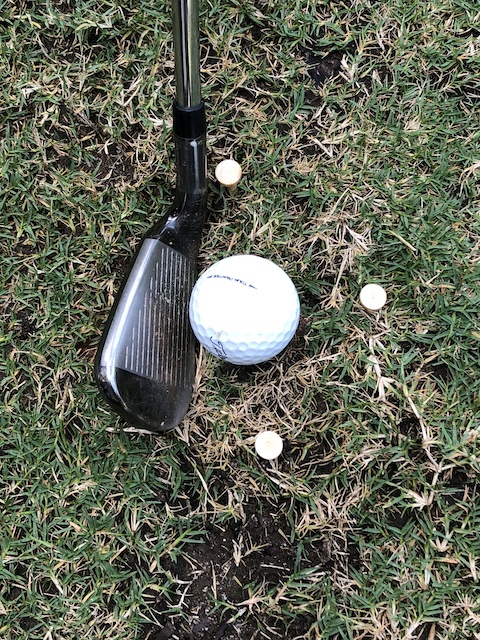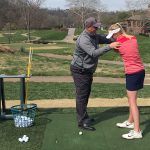What is a good drill for golfers who hit the ball thin and try to lift the ball?
There are two drills I use, which have both helped players learn to apply the club properly, and eliminate thin shots.
It’s very common to see a player trying to “help” the ball in the air, as opposed to using the club properly to launch it. There are two drills I use, which have both helped players learn to apply the club properly, and eliminate thin shots. The great thing is – both of these drills have added value! They can improve swing direction, balance, and off-center strikes, among others.
First take 4 tees and place the ball on a very low tee, put one tee on either side of the toe and heel (leaving a 1/4 of an inch between), and place the final tee 1/2 inch in front of the ball. The goal is to strike the tee in front of the ball without hitting the “gate” tees.
The second drill is to take your back foot (right foot for RH player) and align that toe with the heel of your front foot. You may have to move slightly closer to the golf ball when you address it. From this position, make half-speed swings with the feeling that your body is stable, but your arms are extending through contact.
Try them both!

The Flamingo (All time favorite drill...you're welcome!)
A very common fault for golfers is the thin shot, often mentally a result of trying to lift the ball into the air. Physically, the golfer usually has too much weight back or on the trail side through impact. This causes the club to bottom out before impact and strike the ball on the upswing. Not good for your irons or approach shots!
The Flamingo can help! Stand on your lead leg. Place your trail toe on the ground even with your lead heel with a narrow stance. Knees should be side by side. Get into golf posture and hit half shots with 7 iron through pitching wedge. This drill presets the pressure into your lead side so you can get a true feel of proper impact. The club will bottom out where the pressure is, which should be after impact, towards the target.
Really want to improve your golf game? Get incredible swing tips delivered to your inbox every week.
First of all, let's understand why we hit the ball thin as there are many reasons.
First of all, let’s understand why we hit the ball thin as there are many reasons. However; I’ll focus on the top 3 causes that I have seen throughout my golfing career while conducting lessons:
1. Standing up in the downswing or coming out of posture
2. Flipping the golf club or casting in the downswing
3. Poor ball position in the golf set up
I find the best way to cure someone from hitting it thin is first get their body into a better posture and maintain that posture throughout the swing (at least through impact). However; before we started taking full swings to fix the problem, I like to have my students to utilize the clock in reference to their body. For example: The head is 12 O’clock, the feet are 6 O’clock and for RH golfers back hip is 9 and front hip is 3 O’clock (LH would be the opposite). I would have my students start out with a 8 to 4 swing while keeping the hands around of the clubface; which in turn prevents casting.
Once they have successfully hit a number of solid chip shots (ball in the air and straight), I increase the swing to 9 to 3 and again maintaining the hands ahead of the clubface. After a short period of time, the student becomes very comfortable with this drill and is hitting the ball in the air repeatedly and straight. Once that occurs and only when that occurs do I then increase the length of the swing to 10 to 2 while again keeping hands ahead of the clubface through impact. Please note that with all the different swing lengths, the student is only swinging at a 60% capacity so they can feel the swing; which will help them to repeat it over and over again.

I think the real issue is what is causing the poor impact?
I think the real issue is what is causing the poor impact? Is it the result from a reverse pivot? Is it from reacting to a closed clubface in the backswing and then trying to open it thru impact? Is the angle of attack too shallow or too steep? Once you identify the error then you can address the corrective motion. But generally, the golfer needs to move the bottom of the swing more forward.
Drill: take two tees and place them a foot apart from each other. Then make swings and see if you can get the divot to start even with or slightly in front of the tees (target side). This will indicate you are making the proper weight shift into ones left side and will contact the ball first, then the ground.
This question addresses probably what is the number 1 problem for recreational golfers.
This question addresses probably what is the number 1 problem for recreational golfers. 90% of golfers at impact add loft and present the shaft to the ball with negative shaft lean. This produces a low point a couple of inches behind the ball. Everyday in my teaching I introduce the “punch drill.” For new students that routinely hit fat or thin shots I will suggest they hit nothing but punch shots for the first couple of lessons.
The first thing that most recreational golfers have to realize is that elite golfers reach low point after impact. Most Tour players reach low point as much as 4 inches after impact. In others words the club is still traveling downward even after contact with the ball. I want to be clear, when I say downward, I do not mean steep, the club should be traveling on a shallow, sweeping descending path to the ball. Students are encouraged to picture hitting shots from underneath trees or into a strong headwind. We are trying to reduce dynamic loft which will produce positive shaft lean.
The goal is to feel that the clubhead never gets above the handle throughout the follow thru. A punch shot is simply a finish position in which the shaft is parallel to the ground and the clubhead and grip are at the same height at waist high. They are advised to go no farther than that. I have them focus on the sound of impact. Once they start to groove that punchy finish and experience the sound of compression they are amazed how far the ball travels with such a short finish. In most cases recreational golfers actually hit their irons farther with this drill than they do with their standard full swing.
I do not think its a coincidence that the two greatest ball strikers of all time, Ben Hogan and Lee Trevino were both from Texas. Due to the wind in Texas and hard, crusty soil they had to develop a swing that would keep the clubhead low thru impact and flight the ball down. Thus Hogan and Trevino had a tremendous sound of compression with a ball that made a “sizzling” sound as it rocketed off the clubface.

Part of this is a lack of understanding that the low point of the swing is on the target side of the ball.
I think this is a great question. Part of this is a lack of understanding that the low point of the swing is on the target side of the ball. From the outside it can appear that golf is a “lifting game” that you are trying to help/lift the ball up in the air. Because of this people tend to hang back on their trail leg in an effort to lift the ball off of the ground.
One of the first things people need to learn is how to use their lower bodies, especially on the forward swing. I believe in making the swing athletic, getting them to understand that swinging the club has similar aspects to throwing a ball. The lower body has to lead the forward swing. I like to have them throw me a medicine ball (6 lbs) in the same concept of a golf swing. This is a big eye opener for them.
I also like to put a spot on the ground an inch or two on the target side of where the ball would be and have them try to strike the ground on that spot. After a few successful practice swings we put a ball down and have them try to strike the ball and then the spot on the ground. This is a great non-technical way to get people to let their lower bodies lead the forward swing and then to learn proper ball then turf contact.

Five Ponds Golf Club | Flagler Golf Academy, Warminster, PA
Force yourself to hit down on the ball
One of the best ways to eliminate a “lift” in your golf swing is to force yourself to hit down on the ball with the help of real time feedback! What we will use for real time feedback is a second golf ball, a sleeve of golf balls or an alignment stick and we will place one of those objects approximately 2 ft. behind the ball you intend to strike. The object here is to come over top of the secondary object, steepening your angle of attack, promoting a trapping swing rather than a sweeping one making sure we strike the golf ball before the turf. If done incorrectly you will see, feel and hear the secondary object move as you hit it before you hit the ball you were intending to strike. If done correctly, the secondary object will not move at all during your swing, and your strike will feel and sound more powerful.
The "eyes closed drill".
After demonstrating the physics of what makes the ball go airborne, and why one cannot “lift” the ball successfully, I have my students do the “eyes closed drill”. First with practice swings, take the address position then close the eyes. At first make a backswing only about 2 feet back, then brush the grass on the way to the finishing position of a full swing. Gradually make a bigger backswing until a full swing is made, but if a swing fails to brush the grass, go back to shorter swings and continue. Finally, try this with a live ball–but this is difficult to do if one focuses on the ball instead of the balanced swing motion as a whole.
A couple of good drills to alleviate this
Trying to lift or help the ball into the air could be the most common problem golfers have.
A couple of good drills to alleviate this;
1. Pick a spot, (broken tee, old divot, discolored grass), 3-4 feet in front of the ball in line with your target. Try to swing your club over this spot & swing through the ball, not at the ball. This will let the club do the work.
2. Angle a tee into the ground towards the target. Imagine your club is a hammer, how would you “drive” the tee, (stake), into the ground. This should help you swing through the ball, because if you swing at it, there will be no force behind it.
Practice a Knock Down type shot.
Practice a Knock Down type shot.
Backswing: 3/4 backswing with wrist hinge. Finish: straight wrist finish, straight arm finish where Club is pointing directly to the target.
Make some half shots with most of your weight on the front leg and leave it there.
Make some half shots with most of your weight on the front leg and leave it there. This will promote a downward strike creating ball/turf contact.

Think about getting the toe of the club to the target
This is a problem for so many golfers as they try to “lift” or “hit” the ball instead of swinging the club to the target. My main thought for the player is to think about getting the toe of the club to the target. By swinging the club and having the toe go to the target they are releasing the club better and their right shoulder gets through the hitting zone better. Contact is much more solid and ball flight tends to be more ideal for the player.
Hit shots off a down hill lie
Have them hit shots off a down hill lie. This will get them swinging down the hill letting the club get the ball in the air. Also work on proper weight transfer.
Stick a tee an inch or so in front of the ball
Stick a tee an inch or so in front of the ball you’re hitting and try to hit that tee out of the ground.
Relax your grip and be on lead side at impact.
Relax your grip and be on lead side at impact. Most amateurs have a lot of weight on the trail side of the body at impact. Tour players have 90 of weight on lead foot at the strike.
The best drill I have used is the "broken tee drill"
This is a very common mistake. The best drill I have used is the “broken tee drill”. Take a broken tee and place it directly in front of your ball. After you take your set-up, please focus directly on the broken tee instead of the golf ball. Now try and directly hit the tee instead of the golf ball. This will make the swing steeper and allow the club to keep descending down through impact. After your follow through, you will notice the tee gone and your ball flying high in the air.












